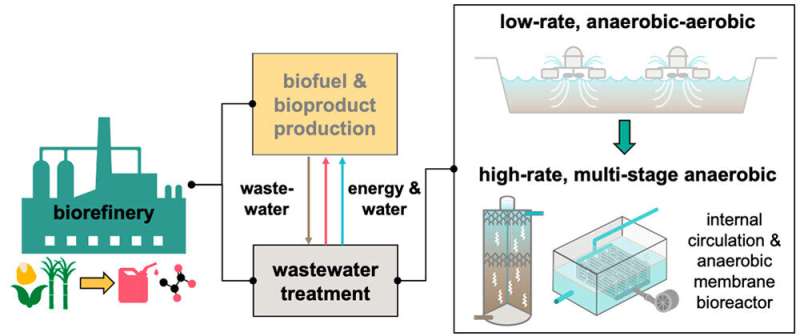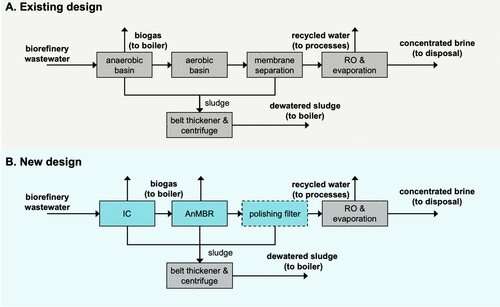This article has been reviewed according to Science X's editorial process and policies. Editors have highlighted the following attributes while ensuring the content's credibility:
fact-checked
trusted source
proofread
Wastewater to energy: New treatment process can improve biorefinery sustainability

Wastewater from biorefineries that convert plants into fuel is full of organic materials that cannot be efficiently treated with conventional wastewater systems, making it costly and energy-intensive to manage.
However, those rich organic materials are an untapped source of chemical energy that can be recovered as valuable products, including biogas, a clean-burning renewable fuel.
A study by researchers at the Department of Energy's Center for Advanced Bioenergy and Bioproducts Innovation (CABBI) found that recovering resources from wastewater can substantially improve the economic and environmental sustainability of second-generation biorefineries, supporting the transition to a sustainable, plant-based biofuels and bioproducts industry.
The CABBI team designed a process that simultaneously treats wastewater and recovers biogas energy that could generate revenue for biorefineries—while lowering costs and greenhouse gas emissions compared to conventional treatment systems.
The work, published in ACS Sustainable Chemistry & Engineering, united researchers from all three CABBI themes—Feedstock Production, Conversion, and Sustainability—who are developing plant-based alternatives to petroleum for fuels and chemical products.
With a "plants as factories" model, they aim to produce biofuels, biochemicals, and foundation molecules directly in plant leaves and stems; develop unique tools, yeasts, and processing methods to convert them into high-value bioproducts, such as biodiesel, organic acids, lubricants, and alcohols; and assess the economic and ecological sustainability of CABBI feedstocks, biofuels and bioproducts, from the field to the biorefinery to the bioeconomy.
The wastewater study was led by two CABBI Sustainability researchers at the University of Illinois Urbana-Champaign: Jeremy Guest, Associate Professor of Civil and Environmental Engineering (CEE); and Research Scientist Yalin Li of the Institute for Sustainability, Energy, and Environment (iSEE).
CABBI co-authors included Vijay Singh, Conversion researcher, Deputy Director for Science & Technology, and Professor of Agricultural and Biological Engineering (ABE) at Illinois; and Feedstock Production researcher Fredy Altpeter, Professor of Agronomy at the Institute of Food and Agricultural Sciences at the University of Florida.

Second-generation biorefineries that process miscanthus, corn stover, or other non-food feedstocks have the potential to produce biofuels and bioproducts with much lower environmental impact than those from fossil fuels or first-generation biorefineries, which use corn and other edible crops. But these second-generation biorefineries still face financial hurdles that prevent their successful deployment in the real world.
If not properly managed, biorefineries can require a prohibitive amount of water and generate a large wastewater stream. To produce fuel and valuable biochemicals from plant biomass, biorefineries can use up to 10 liters of water per liter of biofuel produced, based on a previous CABBI study. The resulting wastewater has high concentrations of organic material—sugars, residual fermentation products, process byproducts, or other chemicals—making it difficult to reuse.
But those prior analyses are often based on conventional, low-rate wastewater treatment technologies that are expensive, energy-intensive, and require a huge physical footprint—which, depending on the size of the plant, could be equivalent to 30 football fields or more. Low-rate conventional treatment systems use large aerobic reactors, which consume large amounts of electricity for aeration, and convert the organic materials from the wastewater to carbon dioxide without creating valuable products.
The CABBI team designed a high-rate anaerobic-dominant wastewater process that largely eliminated aeration, saving electricity, and instead incorporated emerging technologies, including internal circulation and anaerobic membrane bioreactors to recover the embedded energy in the organic materials as biogas.
For their design, they used experimental data from wastewater generated by the processing of sugarcane and oilcane cultivated by the Altpeter group for CABBI's Feedstocks to Fuels project. The process extracts the plant's oils and then generates ethanol from plant sugars through fermentation by yeasts. The Singh group provided spent fermentation broth, after the ethanol was extracted, and collaborators from the Pontificia Universidad Católica de Chile determined how much methane could be produced from the real samples.
Using their open-source software BioSTEAM, the researchers then simulated the integration of the new wastewater treatment process into seven biorefinery designs, covering a wide range of feedstocks and biofuels/bioproducts. Through techno-economic analysis and life cycle assessment (TEA-LCA) enabled by BioSTEAM, they found that the new process could substantially reduce the capital cost and energy usage of biorefineries, improving their financial viability and reducing their environmental impact.
The process could efficiently convert organic contaminants in biorefinery wastewater to biogas, achieving simultaneous energy recovery and wastewater treatment. It would reduce energy consumption, operating costs, and greenhouse gas emissions compared to conventional treatment systems.
"Through proper management processes, wastewater can be a potential source of revenue for biorefineries while improving the environmental sustainability of biofuels and bioproducts," Li said.
The wastewater treatment process designed in this study can substantially improve the financial viability of second-generation biorefineries while reducing their environmental impacts, thus contributing to society's transition to a circular bioeconomy—and CABBI's mission to support a viable, sustainable domestic biofuels and bioproducts industry using plant biomass.
More information: Yalin Li et al, Design of a High-Rate Wastewater Treatment Process for Energy and Water Recovery at Biorefineries, ACS Sustainable Chemistry & Engineering (2023). DOI: 10.1021/acssuschemeng.2c07139















